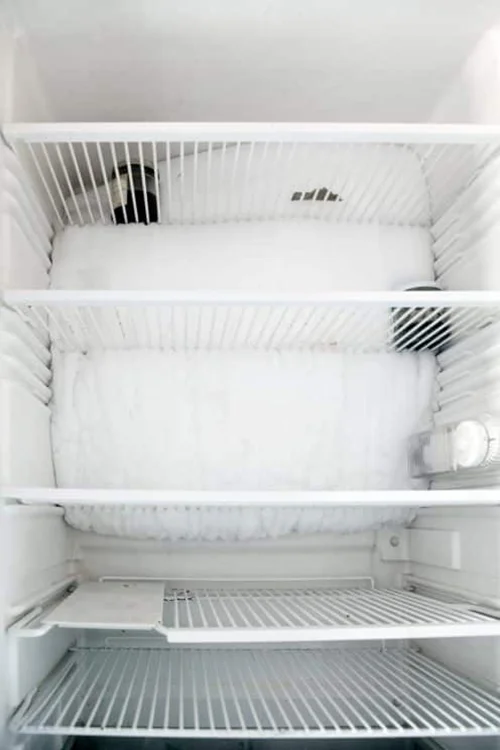It can be a real headache when your fridge freezes up at the back. The good news is that most fridge freezing issues can be resolved with troubleshooting, diagnostics, and actionable solutions. In this guide, we’ll explore the common causes of fridge freezing, diagnostic steps, and Bosch fridge repair.
Understanding the Causes of Fridge Freezing

Temperature Settings:
- The temperature setting in your fridge plays a crucial role in preventing freezing issues. If it’s set too low, your fridge may become excessively cold, leading to frost buildup. To avoid this problem, ensure that your temperature setting is appropriate. Ideally, your fridge should be set at around 37°F (3°C) and your freezer at 0°F (-18°C). Make sure to use a reliable thermometer to check and adjust the settings if necessary.
Blocked Airflow
- Proper airflow is essential for even cooling inside your refrigerator. When vents and passages are blocked, cold air can become trapped, leading to frost accumulation. To resolve this issue, start by inspecting your fridge’s interior. Make sure that there are no items obstructing the vents or air passages. Keeping your fridge organized can go a long way in ensuring good airflow.
Thermostat Issues
- A malfunctioning thermostat can result in erratic temperature control, causing your fridge to freeze up. To diagnose thermostat issues, you can perform a simple test. Place a thermometer in a glass of water and leave it in the fridge overnight. If the temperature remains constant, your thermostat is likely functioning well. However, if it fluctuates significantly, you may need to have it checked and potentially replaced by a professional.
Damaged Door Gaskets
- The gaskets or seals around your fridge and freezer doors are responsible for keeping cold air in and warm air out. Damaged or worn gaskets can lead to temperature fluctuations, causing frost buildup. To check for gasket issues, visually inspect the seals for any visible damage or wear. If you notice problems, such as cracks or gaps, consider repairing or replacing the gaskets to ensure a proper seal.
Troubleshooting and Diagnostics
The first step in resolving fridge freezing issues is to identify the problem. Signs of frost buildup include ice forming on the back wall, frozen water droplets, or an overly cold fridge compartment. Keep an eye out for these symptoms, as early detection is key to effective troubleshooting.
Diagnostic Steps for Effective Troubleshooting
If you’ve noticed frost buildup in your fridge, follow these diagnostic steps:
- Initial Inspection of Frosty Areas: Begin by examining the frosty areas in your fridge. The back wall and air vents are common trouble spots. Take note of the severity of the frost accumulation.
- Checking Temperature Settings: Verify that your fridge and freezer are set at the recommended temperatures. Adjust them if necessary to prevent further freezing.
- Examining Airflow and Ventilation: Ensure that air vents and passages are clear of obstructions. Reorganize the items in your fridge to promote better airflow.
- Testing the Thermostat Function: Perform the thermostat test mentioned earlier to confirm proper function. Seek professional help if needed.
- Inspecting and Assessing Door Gaskets: Examine the door gaskets for damage and wear. Address any issues with repairs or replacements as required.
By following these diagnostic steps, you’ll be well-equipped to identify the root cause of your fridge freezing problem.
Actionable Solutions for a Frost-Free Fridge
Improving Airflow
- Once you’ve identified the issues causing frost buildup, the next step is to implement actionable solutions. To enhance airflow:
- Reorganize your fridge items to ensure air vents and passages are clear.
- Keep a reasonable amount of space between items on shelves to allow for proper ventilation.
Calibrating or Replacing the Thermostat
- If thermostat issues are at the heart of the problem:
- Calibrate the thermostat according to the manufacturer’s instructions to ensure accurate temperature control.
- If calibration isn’t effective or the thermostat is malfunctioning, consult a professional for repair or replacement.
Repairing or Replacing Gasket Seals
- For damaged door gaskets:
- Repair minor issues like gaps or minor tears with a gasket repair kit.
- If gasket damage is severe or beyond repair, consider replacing the gaskets to restore an effective seal.
Implementing DIY Fixes
- In addition to the above solutions, there are some general DIY fixes that can help prevent fridge freezing:
- Use airtight containers to store food items that are prone to moisture, preventing excess humidity in the fridge.
- Regularly defrost your freezer to keep ice buildup in check.
Preventive Maintenance for Long-Term Fridge Health
Maintaining a Frost-Free Fridge
- Once you’ve resolved the current issue, it’s crucial to establish practices that will keep your fridge frost-free over the long term. Here are some tips:
- Keep your refrigerator organized to maintain proper airflow.
- Clean the condenser coils at least twice a year to ensure efficient cooling.
- Periodically check and clean the drain pan to prevent blockages.
Establishing a Regular Maintenance Routine
- To ensure your fridge remains in top shape, create a maintenance routine that includes the following tasks:
- Regularly check the door gaskets for any signs of damage or wear.
- Clean the interior of your fridge and freezer at least once a month.
- Inspect the door hinges and handles for any loose or damaged parts.